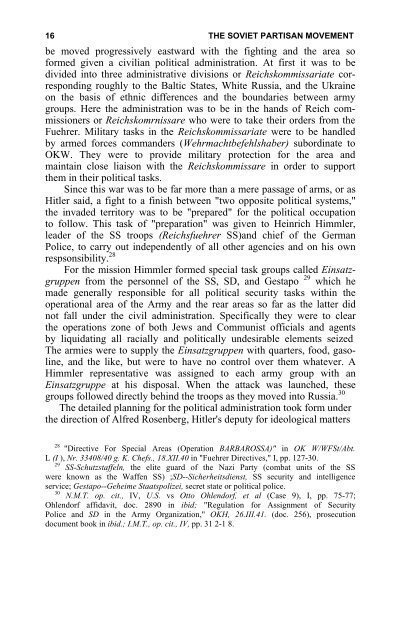the soviet partisan movement 1941-1944 by edgar m. howell
the soviet partisan movement 1941-1944 by edgar m. howell
the soviet partisan movement 1941-1944 by edgar m. howell
You also want an ePaper? Increase the reach of your titles
YUMPU automatically turns print PDFs into web optimized ePapers that Google loves.
16 THE SOVIET PARTISAN MOVEMENT<br />
be moved progressively eastward with <strong>the</strong> fighting and <strong>the</strong> area so<br />
formed given a civilian political administration. At first it was to be<br />
divided into three administrative divisions or Reichskommissariate corresponding<br />
roughly to <strong>the</strong> Baltic States, White Russia, and <strong>the</strong> Ukraine<br />
on <strong>the</strong> basis of ethnic differences and <strong>the</strong> boundaries between army<br />
groups. Here <strong>the</strong> administration was to be in <strong>the</strong> hands of Reich commissioners<br />
or Reichskomrnissare who were to take <strong>the</strong>ir orders from <strong>the</strong><br />
Fuehrer. Military tasks in <strong>the</strong> Reichskommissariate were to be handled<br />
<strong>by</strong> armed forces commanders (Wehrmachtbefehlshaber) subordinate to<br />
OKW. They were to provide military protection for <strong>the</strong> area and<br />
maintain close liaison with <strong>the</strong> Reichskommissare in order to support<br />
<strong>the</strong>m in <strong>the</strong>ir political tasks.<br />
Since this war was to be far more than a mere passage of arms, or as<br />
Hitler said, a fight to a finish between "two opposite political systems,"<br />
<strong>the</strong> invaded territory was to be "prepared" for <strong>the</strong> political occupation<br />
to follow. This task of "preparation" was given to Heinrich Himmler,<br />
leader of <strong>the</strong> SS troops (Reichsfuehrer SS)and chief of <strong>the</strong> German<br />
Police, to carry out independently of all o<strong>the</strong>r agencies and on his own<br />
respsonsibility. 28<br />
For <strong>the</strong> mission Himmler formed special task groups called Einsatzgruppen<br />
from <strong>the</strong> personnel of <strong>the</strong> SS, SD, and Gestapo 29 which he<br />
made generally responsible for all political security tasks within <strong>the</strong><br />
operational area of <strong>the</strong> Army and <strong>the</strong> rear areas so far as <strong>the</strong> latter did<br />
not fall under <strong>the</strong> civil administration. Specifically <strong>the</strong>y were to clear<br />
<strong>the</strong> operations zone of both Jews and Communist officials and agents<br />
<strong>by</strong> liquidating all racially and politically undesirable elements seized<br />
The armies were to supply <strong>the</strong> Einsatzgruppen with quarters, food, gasoline,<br />
and <strong>the</strong> like, but were to have no control over <strong>the</strong>m whatever. A<br />
Himmler representative was assigned to each army group with an<br />
Einsatzgruppe at his disposal. When <strong>the</strong> attack was launched, <strong>the</strong>se<br />
groups followed directly behind <strong>the</strong> troops as <strong>the</strong>y moved into Russia. 30<br />
The detailed planning for <strong>the</strong> political administration took form under<br />
<strong>the</strong> direction of Alfred Rosenberg, Hitler's deputy for ideological matters<br />
28<br />
"Directive For Special Areas (Operation BARBAROSSA)" in OK W/WFSt/Abt.<br />
L (I ), Nr. 33408/40 g. K. Chefs., 18.XII.40 in "Fuehrer Directives," I, pp. 127-30.<br />
29<br />
SS-Schutzstaffeln, <strong>the</strong> elite guard of <strong>the</strong> Nazi Party (combat units of <strong>the</strong> SS<br />
were known as <strong>the</strong> Waffen SS) ;SD--Sicherheitsdienst, SS security and intelligence<br />
service; Gestapo--Geheime Staatspolizei, secret state or political police.<br />
30<br />
N.M.T. op. cit., IV, U.S. vs Otto Ohlendorf, et al (Case 9), I, pp. 75-77;<br />
Ohlendorf affidavit, doc. 2890 in ibid; "Regulation for Assignment of Security<br />
Police and SD in <strong>the</strong> Army Organization," OKH, 26.III.41. (doc. 256), prosecution<br />
document book in ibid.; I.M.T., op. cit., IV, pp. 31 2-1 8.
















